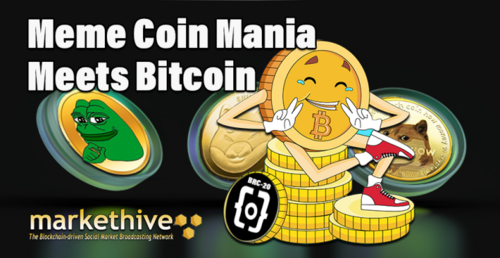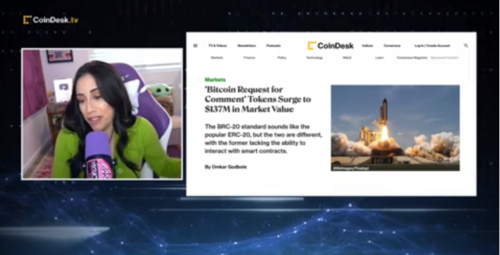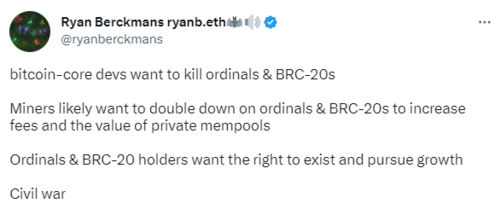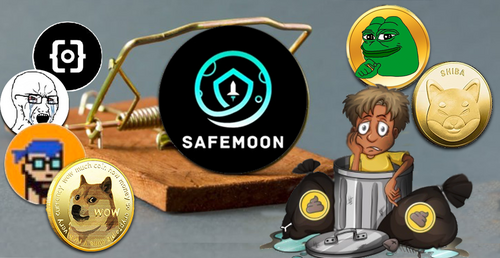
Meme Coin Mania Meets Bitcoin: BRC-20 Offers New Challenges for Bitcoin Investors.
.png)
The world of cryptocurrency is no stranger to innovation and disruption. From the advent of Bitcoin in 2009 to the rise of Ethereum and the explosion of decentralized finance (DeFi), the crypto space has been at the forefront of technological advancement and financial experimentation. But in recent months, a new phenomenon has taken the crypto world by storm: meme coins.
These digital assets have little to no fundamental value but have gained massive popularity thanks to social media hype and viral marketing. Some of the most famous meme coins include Dogecoin, Shiba Inu, and SafeMoon. These coins have captured the imagination of millions of people worldwide, leading to a surge in demand and a corresponding increase in their market value.
But meme coins may not totally be a fad. They are also changing how we think about digital assets and blockchain technology. And with the introduction of the BRC-20 token standard, meme coins are now becoming part of the Bitcoin ecosystem, offering new opportunities for investors and enthusiasts alike. Investors are now experiencing a massive shift in the Bitcoin (BTC) ecosystem thanks to the new experimental token standard called "Bitcoin Request for Comment," or BRC-20, which has attracted much interest.
Over 4 million Ordinal inscriptions have been recorded on the Bitcoin blockchain as of the time of this writing. This new invention has the crypto community buzzing, with about 18,266 BRC-20 tokens created utilizing Ordinals and a soaring market capitalization reaching $409 million. Recently, non-ordinal BRC-20 transactions have been eclipsed by transactions involving the deployment, minting, and transfer of tokens. The proportion of BRC-20 transactions peaked on May 7 at 65%, demonstrating the protocol's expanding uptake.

Video source: Coindesk.com
Unlocking Bitcoin's Potential
For usage in smart contract applications, BRC-20 tokens are a cryptocurrency that operates on the Bitcoin network. BRC-20 transactions, in contrast to standard Bitcoin transactions, require the user to inscribe a new ordinal, lengthening the queue in the Bitcoin mempool. The size of BRC-20 tokens is around ten times smaller than picture inscriptions, although the mempool memory utilization is now lower than in March.
The average transaction price increased to $18.9, the highest level since May 2021, despite the decreased mempool utilization. This is brought on by the lengthy mempool wait, which makes users pay a higher gas charge for the miners to complete their transactions. The percentage of fees from Ordinals transactions has risen to 61%, with 99.5% coming from BRC-20. The fact that there has been a noticeable increase from the previous levels shows that BRC-20 is becoming increasingly popular within the Bitcoin community.
The percentage of transaction fees increased significantly from the 1-2% level seen since July 2021 to 31% on May 7. It's vital to remember that the costs are modest when expressed in BTC, even though this fee increase may worry some Bitcoin users.
The Revolutionary Approach And Utility Of BRC-20
BRC-20 tokens have attracted much interest in the cryptocurrency sector, but their usability and DeFi capabilities still have the potential for improvement. BRC-20 tokens may see an upgrade in their DeFi capabilities due to the possibility of a layer 2 solution like Stacks to bridge BRC-20s, which may draw in additional users and investors. It will be interesting to see whether BRC-20 tokens can surpass their present restrictions and gain more excellent traction as a cryptocurrency.
Despite rising popularity and market capitalization, the utility of BRC-20 coins is still constrained by the absence of smart contract functionality. However, the possibility for a layer 2 solution might improve their DeFi capabilities, which could lead to a cryptocurrency that is more commonly used.

Image source: Twitter
Bitcoin Community Reacts
Since its introduction by a developer going by the fictitious name Domo in March, the BRC-20 token standard has generated a lot of discussion within the Bitcoin community. Using the Ordinals protocol, BRC-20 tokens make it simple for developers to manufacture fungible crypto assets. Individuals must encode JSON data containing crucial token information to produce a BRC-20 currency. Similar to an ERC-20 token contract on Ethereum, this information would provide essential information about the token, such as its name, symbol, and total quantity.
As of this writing, there are over 300,000 unconfirmed transactions in the Bitcoin mempool due to the spectacular issue of over 18,266 BRC20 tokens and the spike in Ordinal inscriptions exceeding 4 million. Ordspace has a complete list of these 10K+ BRC20 currencies and a US dollar value for each token. The BRC20 token economy has seen tokens soar with increases in the triple digits.
These tokens include PEPE, MEME, ORDI, $OG$, PUNK, SHIB, and DOMO, to name a few. A contentious discussion about whether fungible and non-fungible tokens (NFT) built on BTC merit confirmation alongside financial transactions has been rekindled by the storm of BRC-20s and Ordinal inscriptions.
Ethereum supporter Ryan Berckmans described the rivalry between BTC Core devs, miners, and ordinals as a "civil war." BRC-20 meme coins and ordinals are viewed as spam by several developers, including Dashjr. As a result of the rising demand for block space, transactions, and fees have surged, giving the impression that it is experiencing an "Ethereum moment", yet they are advantageous to Bitcoin miners who are making huge profits from this disaster. Divisions within the Bitcoin community are nothing new; they have existed in the past and will probably do so again as long as the crypto sector continues to exist.

Image by Markethive.com
Final Thoughts
The current situation makes it untenable for many who want to use Bitcoin for its intended purpose. When you look at the ideas behind meme coins, you will understand that they are purely pump and dump coins with no actual utility attached to them. However, some argue that utility may come on afterwards, such as in the many NFT projects that started off as a joke.
The thing here is that most of these meme coins are launched by rogues who anonymously build a community through massive advertising campaigns that make people believe in the project. After a while, the project dies off, causing people to lose millions of dollars. The bitter truth about meme coins is that the people are the products or the actual jokes in these projects. Having these projects launched on the Bitcoin Blockchain creates many uncertainties and opportunities, as many would believe.
If you are a Bitcoin maximalist, there's a reasonable probability you're angry. Why? Several people waste block space and pollute the king of crypto with pointless projects. Unfortunately, since NFTs and DeFi on Bitcoin are such a big concern, you can't stop people from doing this.
Bitcoin takes out the corruption of humans because the humans that created it stepped away. Certainly, people will build corrupt and disruptive systems around it, as we see with the meme coins, but Bitcoin remains a simple, pure, and elegant currency. Bitcoin's lack of control by any institution or government empowers individuals with economic freedom and personal sovereignty. It's a game-changer. However, will the era of meme coin end anytime soon? Is Bitcoin the ideal place for this kind of project? Most likely not! We will have to wait and see how it all works out.

Tim Moseley

.png)